The Impact and Correction of Sensitive Environmental Factors on Spectral Reflectance Measured In Situ
Abstract
:1. Introduction
2. Materials and Experimental Design
2.1. Experimental Setup
2.2. Samples, Sampling Sites, and In Situ Measurements
2.3. Simulation Experiments of Field Environmental Factors
2.4. Surface Heterogeneity Experiment
3. Methodology
3.1. Field Data Uncertainty Propagation
3.2. Sobol’s Global Sensitivity Analysis
3.3. Field Data Correction Model
4. Results and Discussion
4.1. Uncertainty Analysis of Field Spectral Reflectance Caused by I&VG
4.1.1. Reference Panel
4.1.2. Rock Samples
4.1.3. Comparison of Reference Panel and Rock Samples
4.2. Sensitivity Analysis of Field Spectral Reflectance to I&VG
4.2.1. First-Order Sensitivity Analysis
4.2.2. Total Sensitivity Analysis
4.2.3. Comparison of First-Order Sensitivity and Uncertainty
4.3. Correction of Field Data under Different I&VG Conditions
5. Conclusions
- The uncertainty and sensitivity caused by different I&VG conditions are closely related to the surface heterogeneity of the object. The greater the surface heterogeneity, the greater the uncertainty.
- Regardless of surface heterogeneity, the uncertainty and sensitivity caused by observation height are greater than those caused by I&VG. Because the observation height directly affects the size of the field of view and the physicochemical characteristics of the measured object within the field of view, the selection of observation height and the avoidance of changes during the experimental process are crucial. And the scale effect can be a noteworthy issue in the future.
- For approximate Lambertian objects, the results of uncertainty and sensitivity are relatively consistent. The uncertainty and sensitivity caused by the solar and view zenith angles are relatively high. This indicates that the selection and variation of the zenith angle are crucial.
- When there is surface heterogeneity on the measured object, the uncertainty caused by the solar and view azimuth angles is relatively high, but it is more sensitive to the solar azimuth angle and solar zenith angle. This indicates that the selection of the solar azimuth angle and the avoidance of changes during the experimental process are crucial. Additionally, more attention should be paid to the changes in the solar zenith angle and the selection of view azimuth angle.
- The correction method for reflectance data under different I&VG conditions proposed in this study has been successfully applied to correct the view zenith angle and has achieved good results, with a correction ability of 41.25%. However, the correction effect for the other four I&VG parameters is not ideal. Therefore, further exploration of correction models for these I&VG parameters will be required in the future.
Author Contributions
Funding
Data Availability Statement
Conflicts of Interest
Appendix A. Simulation Experiment of Field Environmental Conditions
| Index No. | DTS-1 | DTS-2 | DTS-3 | DTS-4 | DTS-5 | DTS-6 | DTS-7 | DTS-8 | DTS-9 | DTS-10 |
|---|---|---|---|---|---|---|---|---|---|---|
| SAM | 0.9975 | 0.9852 | 0.9883 | 0.9820 | 0.9915 | 0.9964 | 0.9829 | 0.9945 | 0.9982 | 0.9884 |
| ED | 0.2107 | 0.2022 | 0.1528 | 0.3046 | 0.1584 | 0.3731 | 0.1932 | 0.4189 | 0.3881 | 0.2755 |
| Index Solar Zenith Angle | SZ_45° | SZ_50° | SZ_55° | SZ_60° | |||||
|---|---|---|---|---|---|---|---|---|---|
| In Situ | HCRF | In Situ | HCRF | In Situ | HCRF | In Situ | HCRF | ||
| 1266 nm | Absorption Peak | 1264 | 1266 | 1266 | 1266 | 1266 | 1266 | 1267 | 1266 |
| Absorption Depth | 0.5691 | 0.5585 | 0.5657 | 0.5642 | 0.5623 | 0.5603 | 0.5535 | 0.5580 | |
| Spectral Absorption Index | 1.0622 | 1.1898 | 1.2185 | 1.2009 | 1.2081 | 1.1894 | 1.0435 | 1.1921 | |
| 1499 nm | Absorption Peak | 1499 | 1498 | 1499 | 1499 | 1499 | 1498 | 1498 | 1498 |
| Absorption Depth | 0.2213 | 0.2075 | 0.1963 | 0.2095 | 0.1994 | 0.2087 | 0.1997 | 0.2076 | |
| Spectral Absorption Index | 1.0072 | 1.0131 | 1.0159 | 1.0150 | 1.0139 | 1.0143 | 1.0157 | 1.0120 | |
| 1757 nm | Absorption Peak | 1756 | 1757 | 1758 | 1758 | 1757 | 1757 | 1758 | 1758 |
| Absorption Depth | 0.1587 | 0.1436 | 0.1294 | 0.1453 | 0.1395 | 0.1444 | 0.1362 | 0.1424 | |
| Spectral Absorption Index | 1.0537 | 1.0557 | 1.0581 | 1.0587 | 1.0033 | 1.0567 | 1.0563 | 1.0537 | |
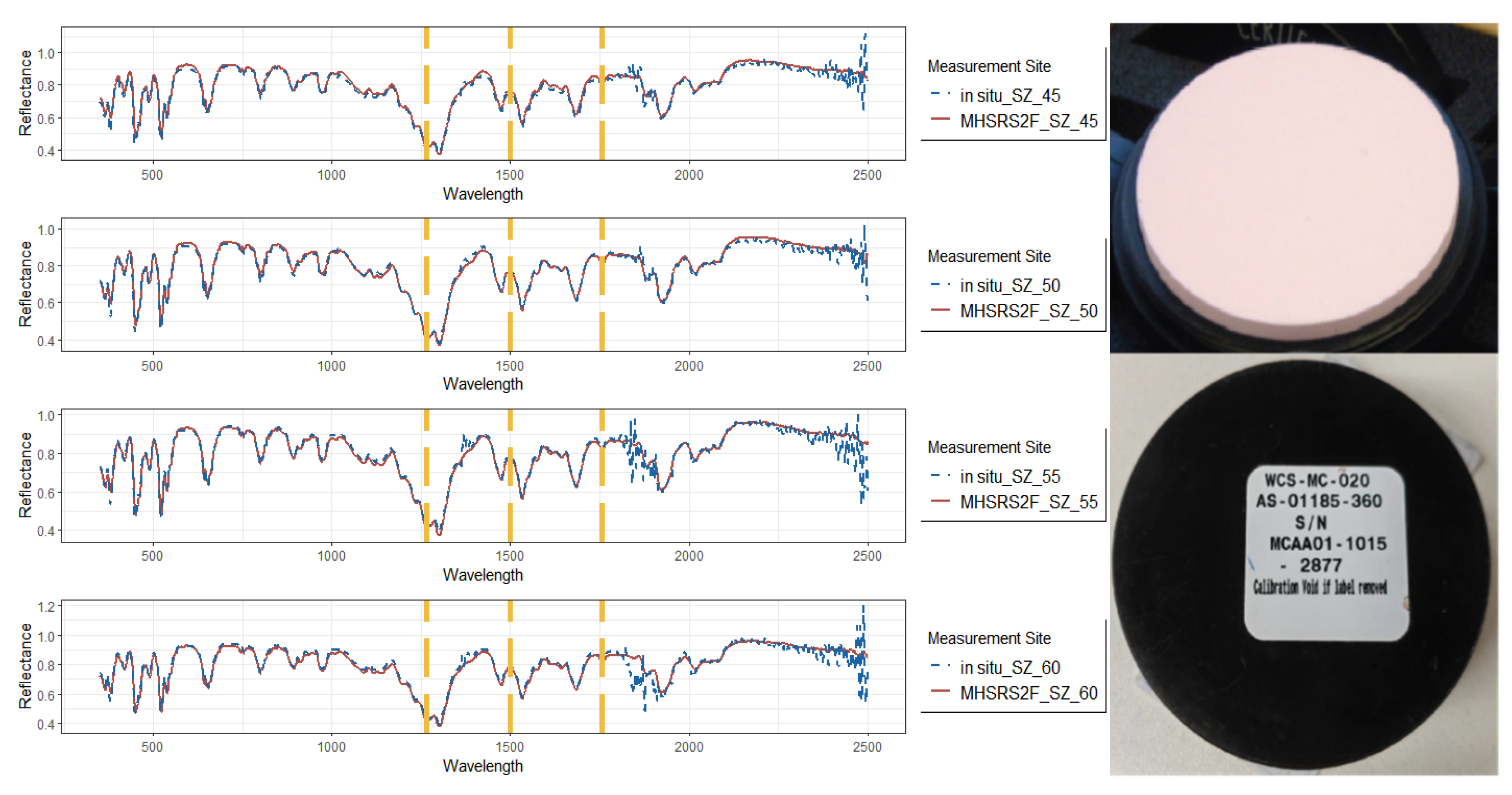
Appendix B. Instrument and Illumination Stability Experiment
| Experiment No. | Sample No. | Atmospheric Type | Aerosol Type | Solar Zenith Angle | View Zenith Angle | Relative Azimuth Angle | Observation Height |
|---|---|---|---|---|---|---|---|
| 1 | DTS21-1 | mid-latitude summer | rural aerosol type | 20° | 0° | 180° | 100 cm |
| 2 | DTS21-1 | mid-latitude summer | rural aerosol type | 30° | 0° | 180° | 100 cm |
| 3 | DTS21-1 | mid-latitude summer | rural aerosol type | 40° | 0° | 180° | 100 cm |
References
- Milton, E.J.; Schaepman, M.E.; Anderson, K.; Kneubühler, M.; Fox, N. Progress in field spectroscopy. Remote Sens. Environ. 2009, 113, S92–S109. [Google Scholar] [CrossRef]
- Milton, E.J.; Rollin, E.M. Estimating the irradiance spectrum from measurements in a limited number of spectral bands. Remote Sens. Environ. 2006, 100, 348–355. [Google Scholar] [CrossRef]
- Brown, L.A.; Camacho, F.; García-Santos, V.; Origo, N.; Fuster, B.; Morris, H.; Pastor-Guzman, J.; Sánchez-Zapero, J.; Morrone, R.; Ryder, J.; et al. Fiducial reference measurements for vegetation bio-geophysical variables: An end-to-end uncertainty evaluation framework. Remote Sens. 2021, 13, 3194. [Google Scholar] [CrossRef]
- Buman, B.; Hueni, A.; Colombo, R.; Cogliati, S.; Celesti, M.; Julitta, T.; Burkart, A.; Siegmann, B.; Rascher, U.; Drusch, M.; et al. Towards consistent assessments of in situ radiometric measurements for the validation of fluorescence satellite missions. Remote Sens. Environ. 2022, 274, 112984. [Google Scholar] [CrossRef]
- Hadley, B.C.; Garcia-Quijano, M.; Jensen, J.R.; Tullis, J.A. Empirical versus model—based atmospheric correction of digital airborne imaging spectrometer hyperspectral data. Geocarto Int. 2005, 20, 21–28. [Google Scholar] [CrossRef]
- Wang, Y.; Leng, P.; Peng, J.; Marzahn, P.; Ludwig, R. Global assessments of two blended microwave soil moisture products CCI and SMOPS with in-situ measurements and reanalysis data. Int. J. Appl. Earth Obs. Geoinf. 2021, 94, 102234. [Google Scholar] [CrossRef]
- Fowler, J.; Waldner, F.; Hochman, Z. All pixels are useful, but some are more useful: Efficient in situ data collection for crop-type mapping using sequential exploration methods. Int. J. Appl. Earth Obs. Geoinf. 2020, 91, 102114. [Google Scholar] [CrossRef]
- Xu, C.; Qu, J.J.; Hao, X.; Zhu, Z.; Gutenberg, L. Surface soil temperature seasonal variation estimation in a forested area using combined satellite observations and in-situ measurements. Int. J. Appl. Earth Obs. Geoinf. 2020, 91, 102156. [Google Scholar] [CrossRef]
- Kraatz, S.; Jacobs, J.M.; Schröder, R.; Cho, E.; Miller, H.J.; Vuyovich, C.M. Improving SMAP freeze-thaw retrievals for pavements using effective soil temperature from GEOS-5: Evaluation against in situ road temperature data over the US. Remote Sens. Environ. 2020, 237, 111545. [Google Scholar] [CrossRef]
- Jiménez, M.; de la Cámara, O.G.; Moncholí, A.; Muñoz, F. Towards a complete spectral reflectance uncertainty model for Field Spectroscopy. In Fifth Recent Advances in Quantitative Remote Sensing; Universitat de València: Valencia, Spain, 2018; p. 21. [Google Scholar]
- Origo, N.; Gorroño, J.; Ryder, J.; Nightingale, J.; Bialek, A. Fiducial Reference Measurements for validation of Sentinel-2 and Proba-V surface reflectance products. Remote Sens. Environ. 2020, 241, 111690. [Google Scholar] [CrossRef]
- Pflug, B.; Louis, J.; de los Reyes, R.; Pflug, K.; Mueller-Wilm, U.; Quang, C.; Iannone, R.Q.; Reinartz, P. Evaluation of SEN2COR surface reflectance products over land surface with reference measurements on ground. In Proceedings of the IGARSS 2022—2022 IEEE International Geoscience and Remote Sensing Symposium, Kuala Lumpur, Malaysia, 17–22 July 2022; pp. 4308–4311. [Google Scholar] [CrossRef]
- Wu, X.; Wen, J.; Xiao, Q.; Liu, Q.; Peng, J.; Dou, B.; Li, X.; You, D.; Tang, Y.; Liu, Q. Coarse scale in situ albedo observations over heterogeneous snow-free land surfaces and validation strategy: A case of MODIS albedo products preliminary validation over northern China. Remote Sens. Environ. 2016, 184, 25–39. [Google Scholar] [CrossRef]
- Qiu, X.; Jia, G.; Zhao, H.; Zhang, C. Antinoise estimation of temperature and emissivity for FTIR spectrometer data using spectral polishing filters: Design and comparison. IEEE Trans. Geosci. Remote Sens. 2020, 59, 3292–3308. [Google Scholar] [CrossRef]
- Biliouris, D.; Verstraeten, W.W.; Dutré, P.; Van Aardt, J.A.; Muys, B.; Coppin, P. A compact laboratory spectro-goniometer (CLabSpeG) to assess the BRDF of materials. Presentation, calibration and implementation on Fagus sylvatica L. Sensors 2007, 7, 1846–1870. [Google Scholar] [CrossRef] [PubMed]
- Ji, C.; Bachmann, M.; Esch, T.; Feilhauer, H.; Heiden, U.; Heldens, W.; Hueni, H.; Lakes, T.; Metz-Marconcini, A.; Schroedter-Homscheidt, M.; et al. Solar photovoltaic module detection using laboratory and airborne imaging spectroscopy data. Remote Sens. Environ. 2021, 266, 112692. [Google Scholar] [CrossRef]
- Peltoniemi, J.; Hakala, T.; Suomalainen, J.; Puttonen, E. Polarised bidirectional reflectance factor measurements from soil, stones, and snow. J. Quant. Spectrosc. Radiat. Transf. 2009, 110, 1940–1953. [Google Scholar] [CrossRef]
- Zhao, F.; Li, Y.; Dai, X.; Verhoef, W.; Guo, Y.; Shang, H.; Gu, X.; Huang, Y.; Yu, T.; Huang, J. Simulated impact of sensor field of view and distance on field measurements of bidirectional reflectance factors for row crops. Remote Sens. Environ. 2015, 156, 129–142. [Google Scholar] [CrossRef]
- Gu, X.F.; Guyot, G.; Verbrugghe, M. Evaluation of measurement errors in ground surface reflectance for satellite calibration. Int. J. Remote Sens. 1992, 13, 2531–2546. [Google Scholar] [CrossRef]
- Anderson, K.; Milton, E.J. On the temporal stability of ground calibration targets: Implications for the reproducibility of remote sensing methodologies. Int. J. Remote Sens. 2006, 27, 3365–3374. [Google Scholar] [CrossRef]
- Anderson, K.; Dungan, J.L.; MacArthur, A. On the reproducibility of field-measured reflectance factors in the context of vegetation studies. Remote Sens. Environ. 2011, 115, 1893–1905. [Google Scholar] [CrossRef]
- Zhao, H.; Cui, B.; Jia, G.; Li, N.; Li, X.; Gan, F.; Yu, J. Acquirement of anisotropy reflectance with the multi-directional hyperspectral remote sensing simulation facility (MHSRS2F). Opt. Express 2019, 27, 28760–28781. [Google Scholar] [CrossRef]
- ASD. ASD Technical Guide, 3rd ed.; Analytical Spectral Devices, Inc.: Boulder, CO, USA, 1999; pp. 1–140. Available online: https://gep.uchile.cl/Biblioteca/radiometr%C3%ADa%20de%20campo/TechGuide.pdf (accessed on 6 August 2023).
- Sobol, I.M. Global sensitivity indices for nonlinear mathematical models and their Monte Carlo estimates. Math. Comput. Simul. 2001, 55, 271–280. [Google Scholar] [CrossRef]
- Saltelli, A.; Tarantola, S.; Chan, K.S. A quantitative model-independent method for global sensitivity analysis of model output. Technometrics 1999, 41, 39–56. [Google Scholar] [CrossRef]
- Nicodemus, F.E.; Richmond, J.C.; Hsia, J.J.; Ginsberg, I.W.; Limperis, T.; Harman, S.; Baruch, J.J. Geometrical considerations and nomenclature for reflectance. In Final Report National Bureau of Standards; US Department of Commerce, National Bureau of Standards: Washington, DC, USA, 1977; Volume 160, p. 52. [Google Scholar] [CrossRef]
- Schaepman-Strub, G.; Schaepman, M.E.; Painter, T.H.; Dangel, S.; Martonchik, J.V. Reflectance quantities in optical remote sensing—Definitions and case studies. Remote Sens. Environ. 2006, 103, 27–42. [Google Scholar] [CrossRef]
- Milton, E.J. Review article principles of field spectroscopy. Remote Sens. 1987, 8, 1807–1827. [Google Scholar] [CrossRef]

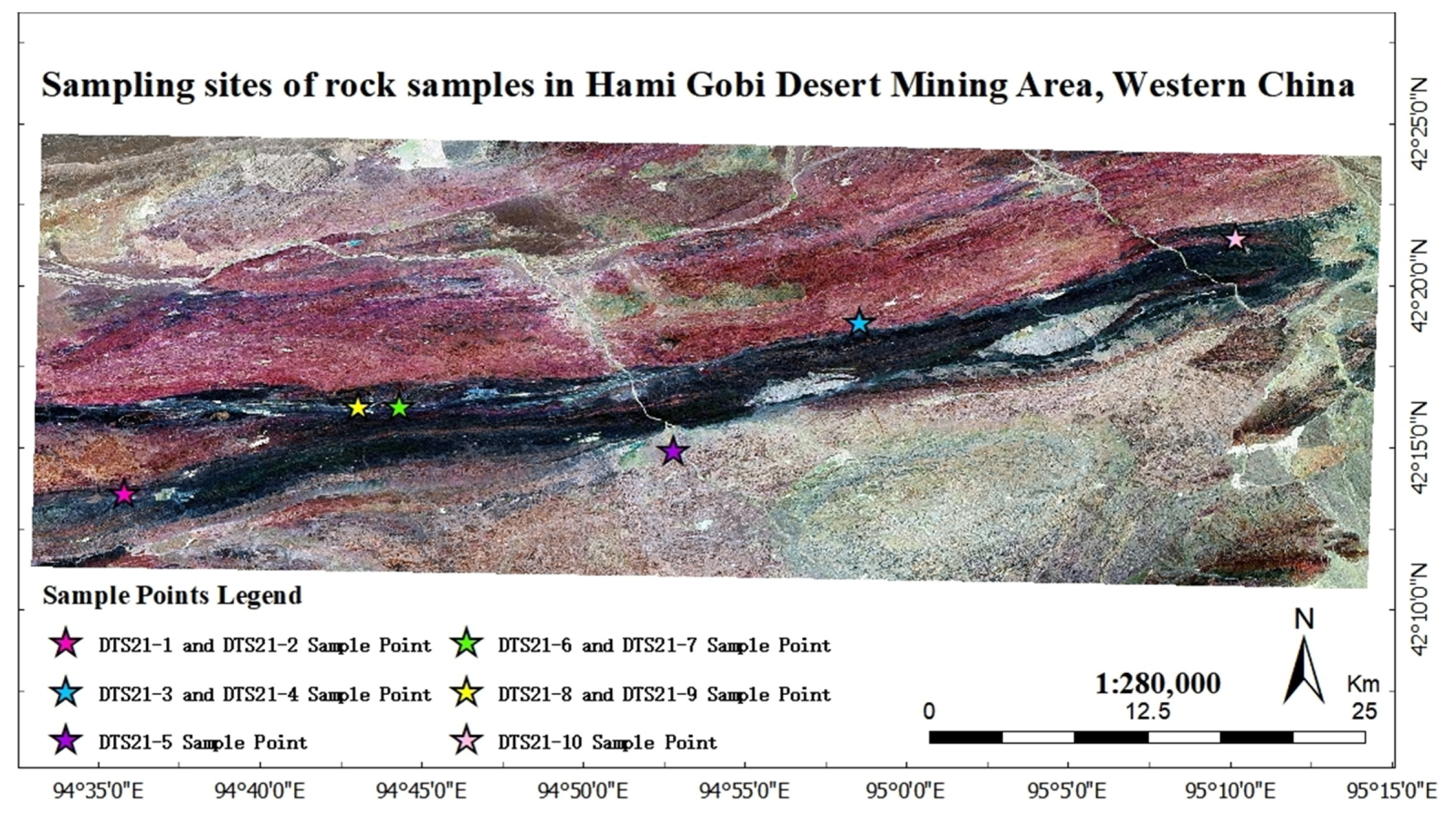

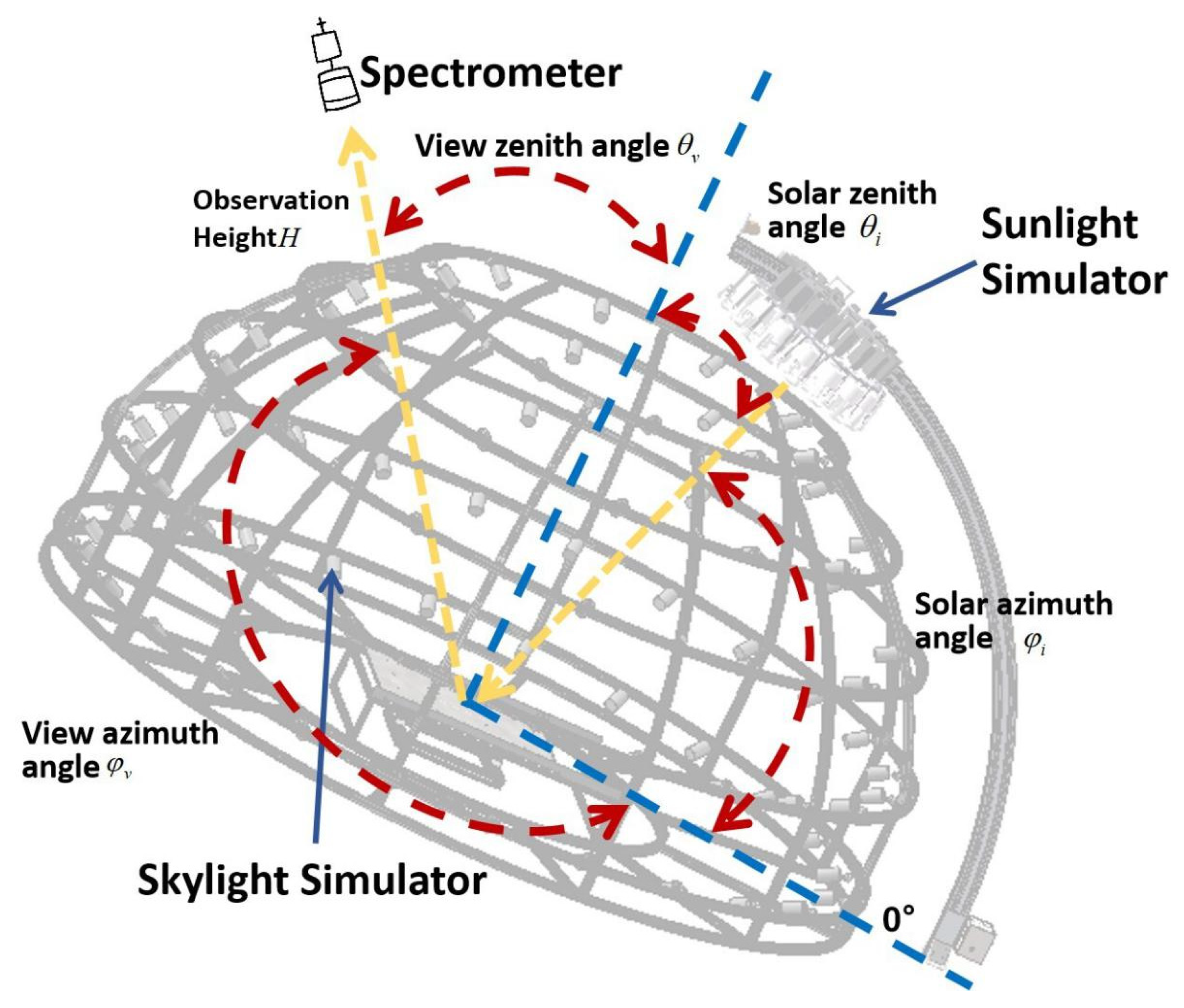

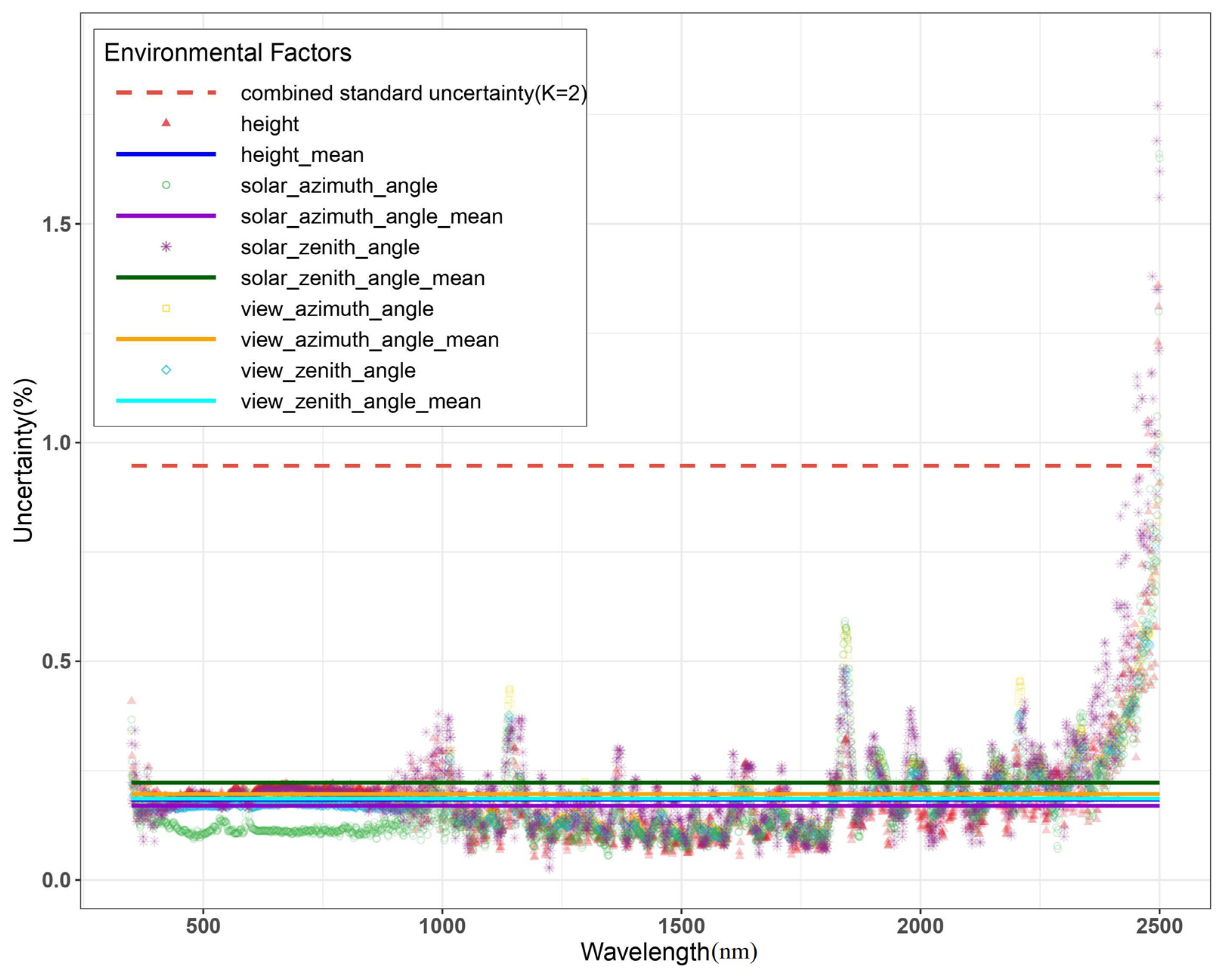

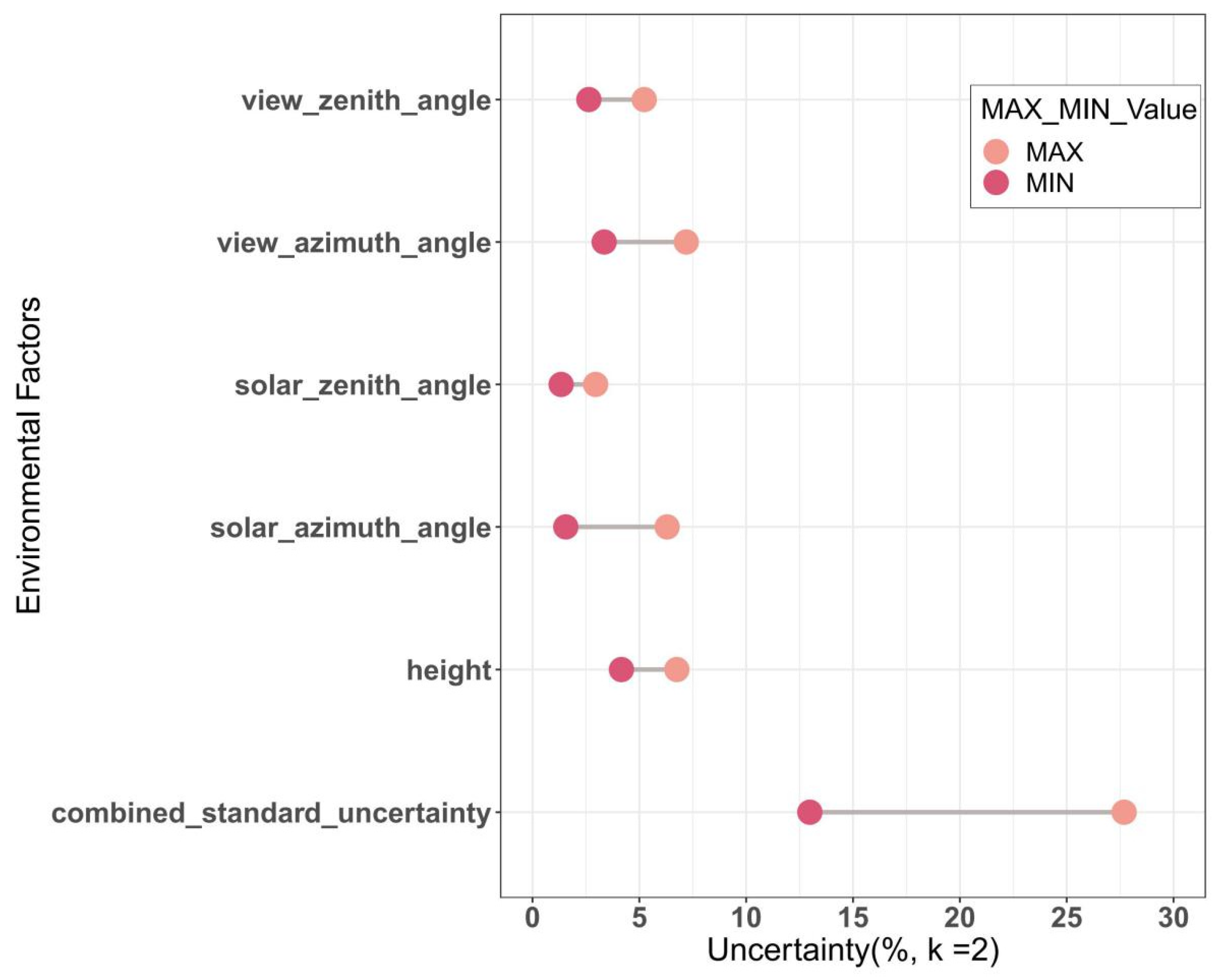
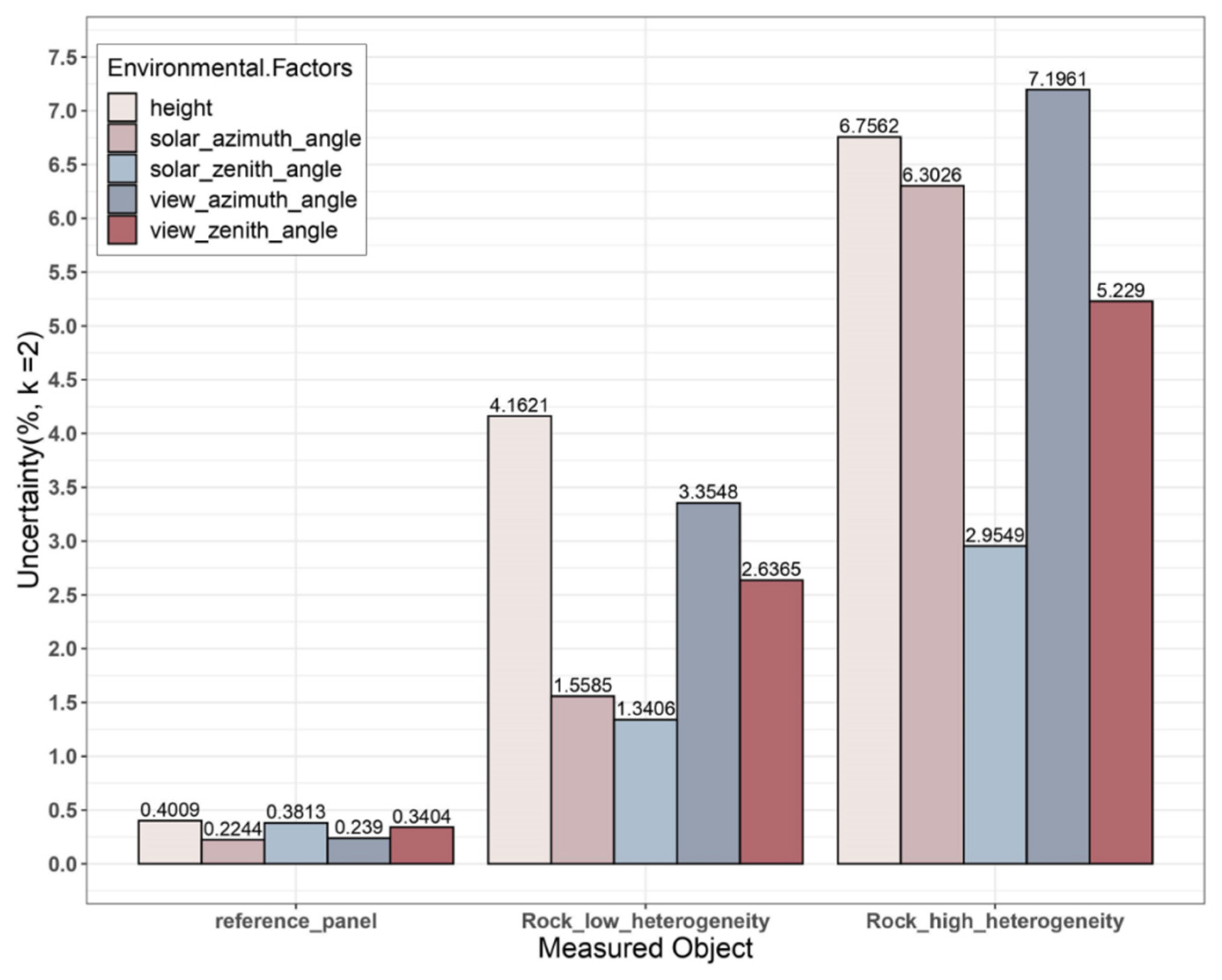
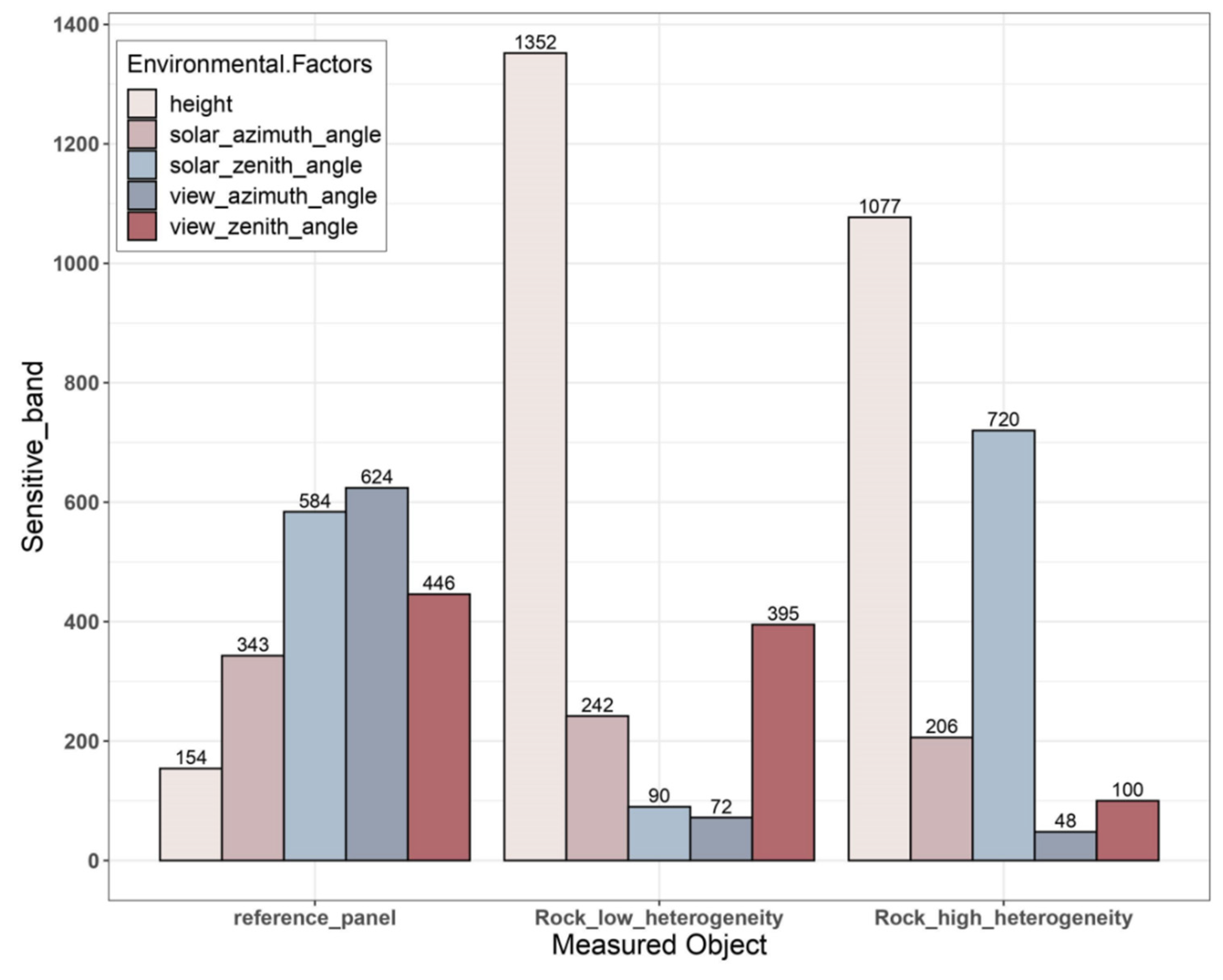
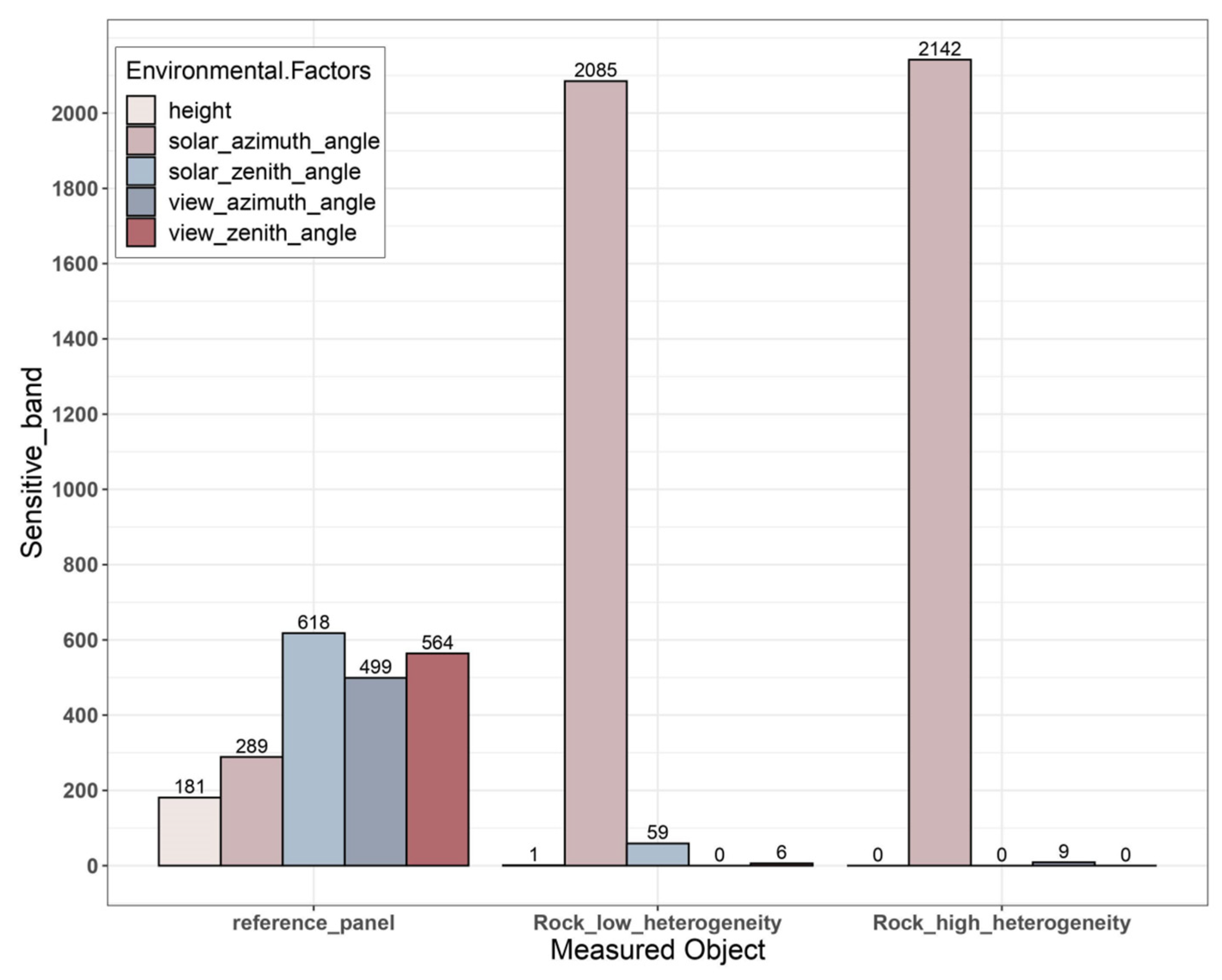
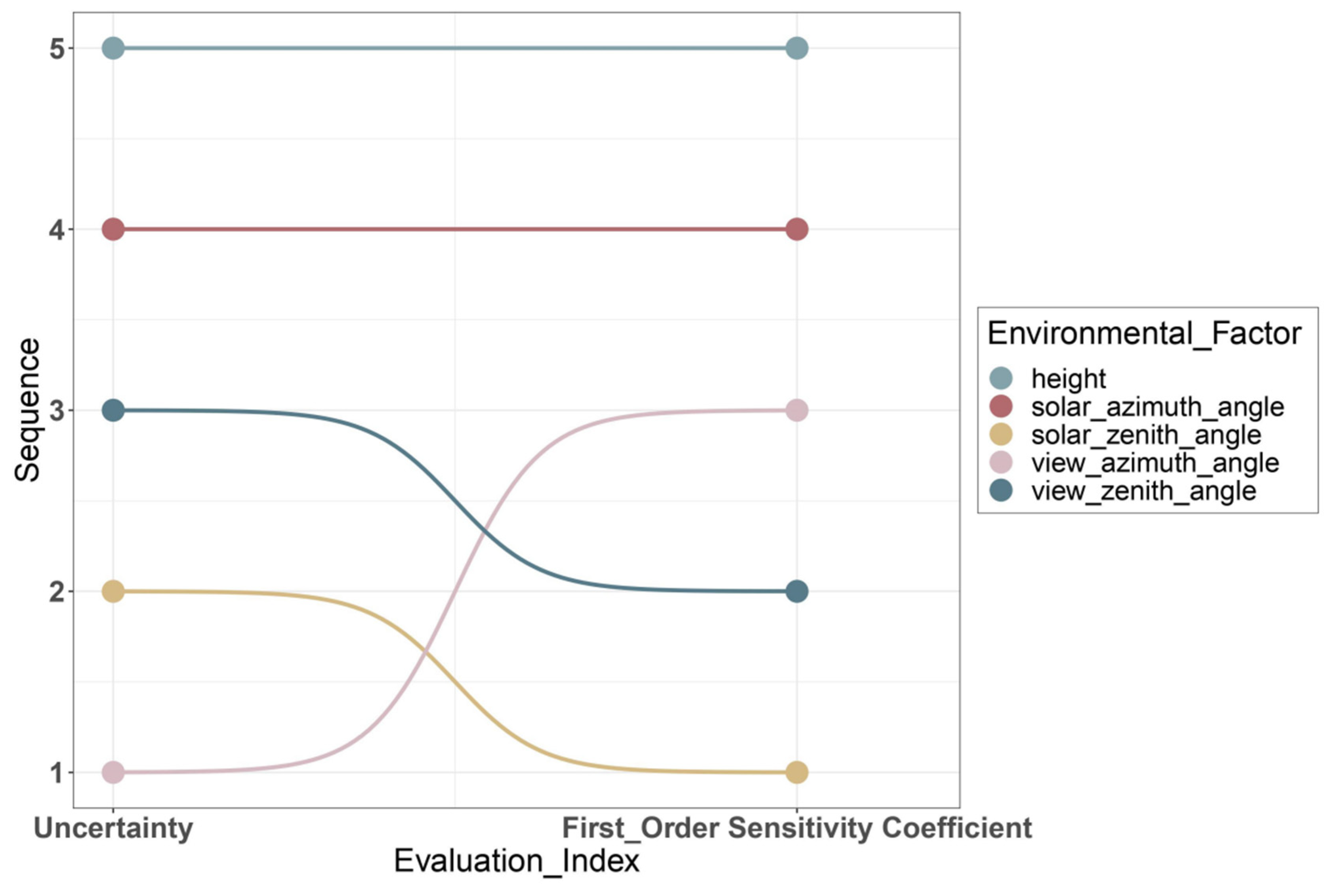
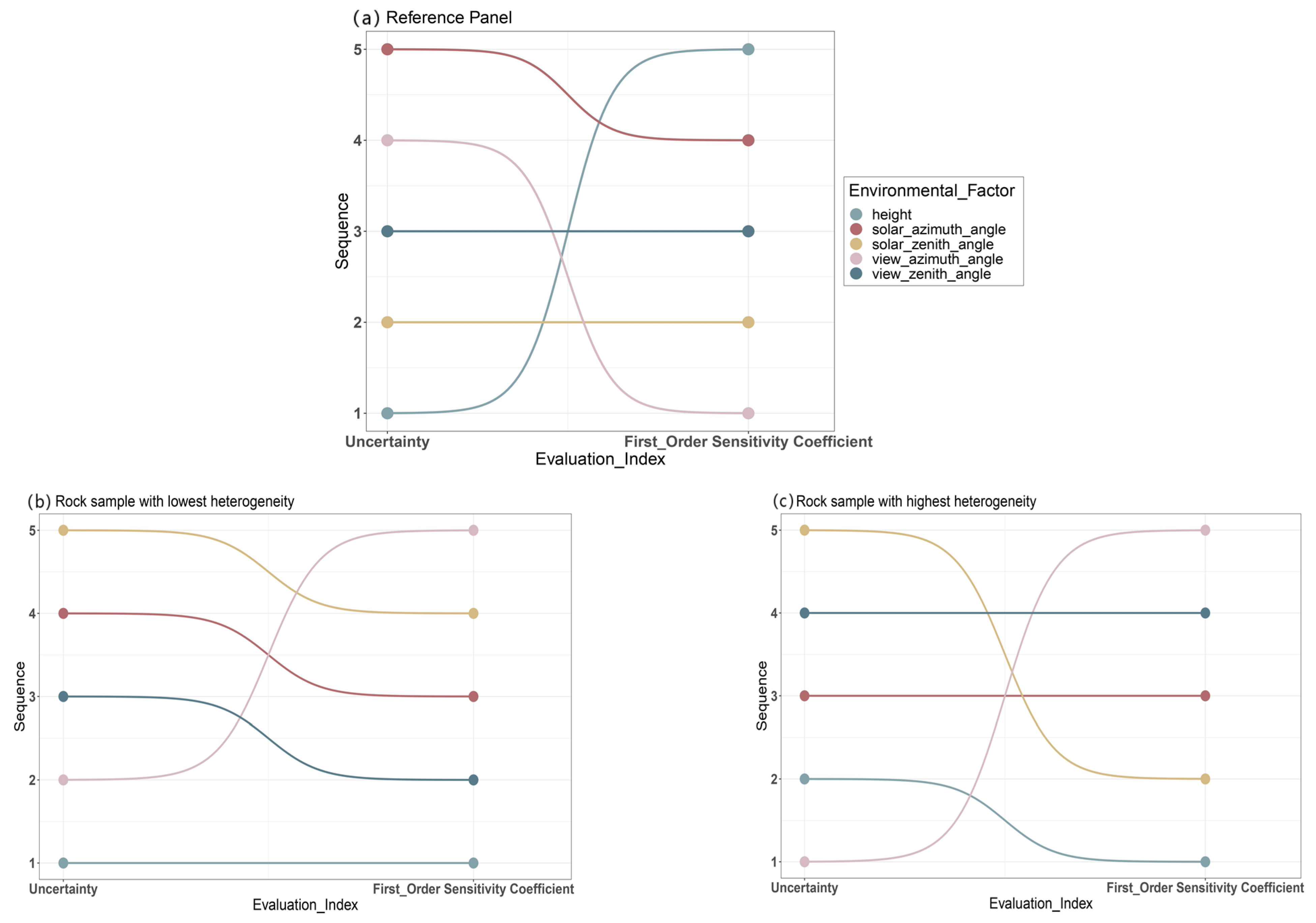
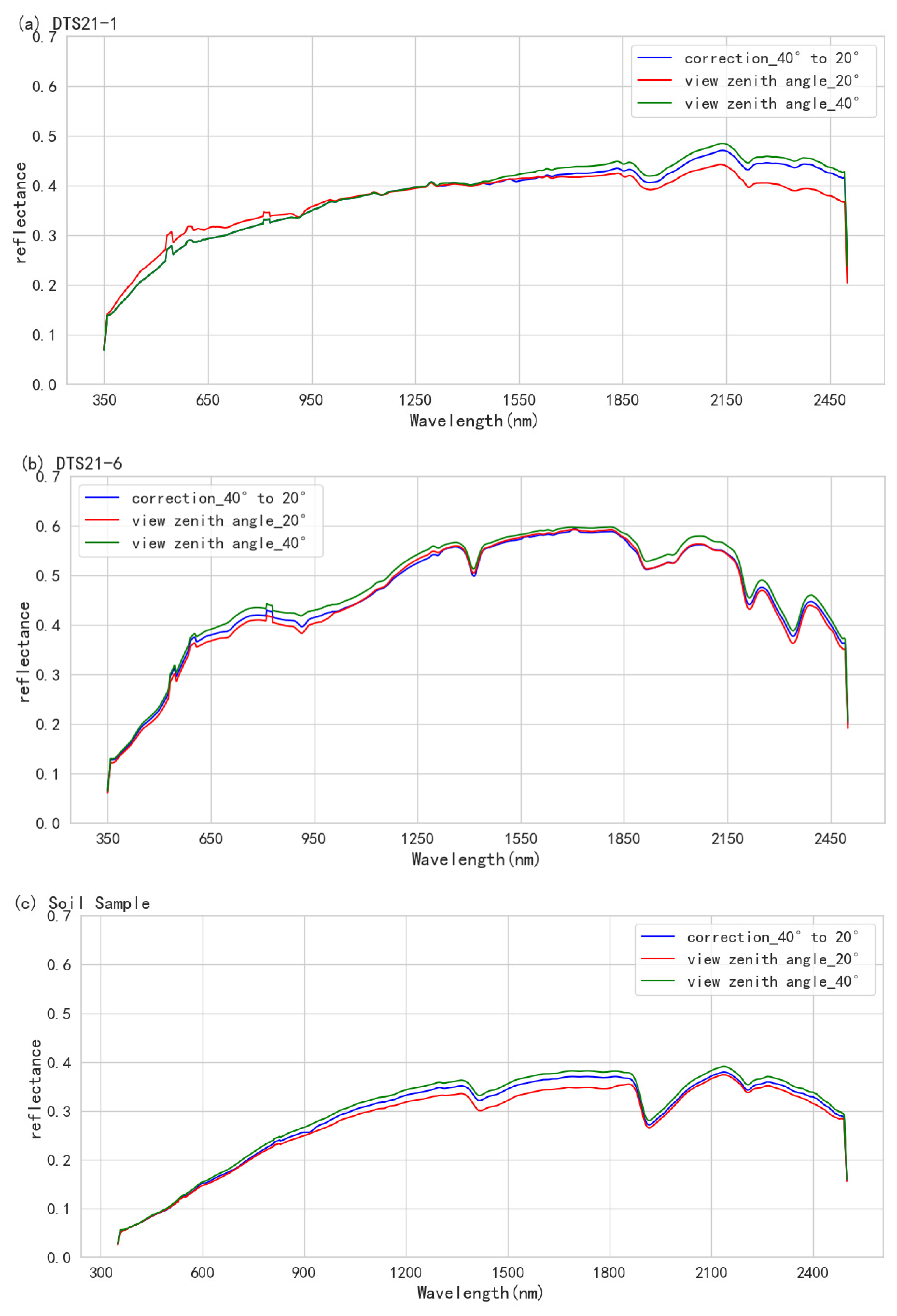
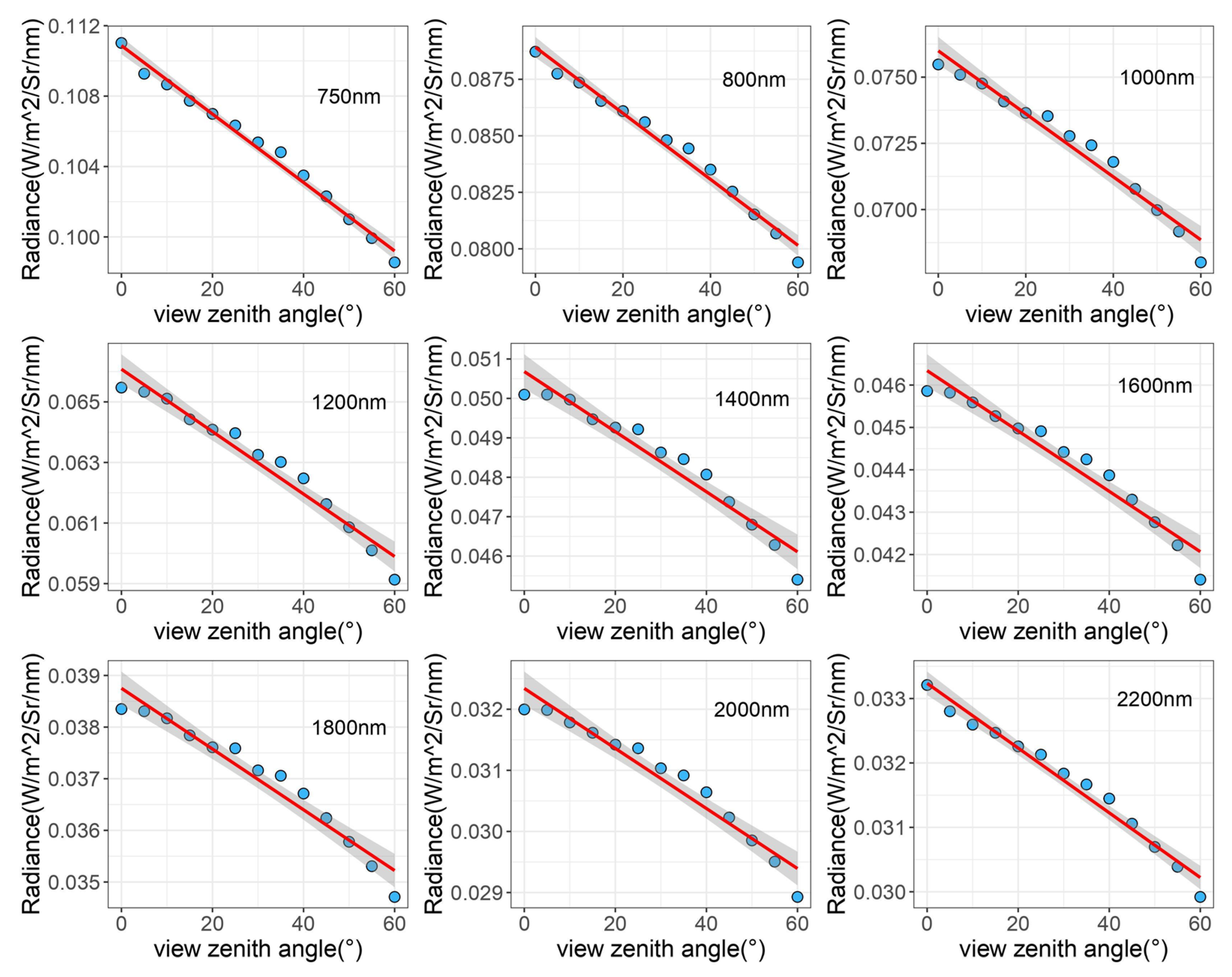

| Sample No. | Date | Time | Latitude (°N) | Longitude (°E) | Solar Zenith Angle | View Zenith Angle | Relative Azimuth Angle | Observation Height |
|---|---|---|---|---|---|---|---|---|
| DTS-1 | 27 July 2021 | 15:12 | 42.2257 | 94.5984 | 48.5° | 0° | 180° | 100 cm |
| DTS-2 | 27 July 2021 | 14:35 | 42.2257 | 94.5984 | 42.0° | 0° | 180° | 100 cm |
| DTS-3 | 12 August 2021 | 13:16 | 42.3145 | 94.9760 | 33.5° | 0° | 180° | 100 cm |
| DTS-4 | 12 August 2021 | 13:18 | 42.3145 | 94.9760 | 33.5° | 0° | 180° | 100 cm |
| DTS-5 | 12 August 2021 | 14:54 | 42.2490 | 94.8801 | 48.7° | 0° | 180° | 100 cm |
| DTS-6 | 14 August 2021 | 11:01 | 42.2713 | 94.7384 | 29.5° | 0° | 180° | 100 cm |
| DTS-7 | 14 August 2021 | 10:53 | 42.2713 | 94.7384 | 30.0° | 0° | 180° | 100 cm |
| DTS-8 | 14 August 2021 | 16:00 | 42.2712 | 94.7168 | 61.0° | 0° | 180° | 100 cm |
| DTS-9 | 14 August 2021 | 16:00 | 42.2711 | 94.7171 | 61.0° | 0° | 180° | 100 cm |
| DTS-10 | 14 August 2021 | 18:05 | 42.3581 | 95.1695 | 84.0° | 0° | 180° | 100 cm |
| Experimental Factors | Solar Zenith | Solar Azimuth | View Zenith | View Azimuth | Observation Height | Adjust Interval |
|---|---|---|---|---|---|---|
| Solar zenith angle | 20–60° | 0° | 0° | 180° | 100 cm | 5° |
| Solar azimuth angle | 20° | 0–360° | 0° | 180° | 100 cm | 10° |
| View zenith angle | 20° | 0° | 0–60° | 180° | 100 cm | 5° |
| View azimuth angle | 20° | 0° | 0° | 0–360° | 100 cm | 10° |
| Observation height | 20° | 0° | 0° | 180° | 10 cm–100 cm | 5 cm |
| Source of Uncertainty | Uncertainty (%) |
|---|---|
| Observation Height | 0.4009 |
| View Zenith Angle | 0.3404 |
| View Azimuth Angle | 0.3604 |
| Solar Zenith Angle | 0.3813 |
| Solar Azimuth Angle | 0.2309 |
| Combined Standard Uncertainty | 0.8579 |
| Source of Uncertainty | Uncertainty Range (%) |
|---|---|
| Observation Height | 4.1621–6.7562 |
| View Zenith Angle | 2.6365–5.2290 |
| View Azimuth Angle | 3.3548–7.1961 |
| Solar Zenith Angle | 1.3406–2.9549 |
| Solar Azimuth Angle | 1.5585–6.3026 |
| Combined Standard Uncertainty | 12.9801–27.6886 |
Disclaimer/Publisher’s Note: The statements, opinions and data contained in all publications are solely those of the individual author(s) and contributor(s) and not of MDPI and/or the editor(s). MDPI and/or the editor(s) disclaim responsibility for any injury to people or property resulting from any ideas, methods, instructions or products referred to in the content. |
© 2023 by the authors. Licensee MDPI, Basel, Switzerland. This article is an open access article distributed under the terms and conditions of the Creative Commons Attribution (CC BY) license (https://creativecommons.org/licenses/by/4.0/).
Share and Cite
Zhao, H.; Wang, Z.; Jia, G.; Tian, J.; Jin, S.; Liang, S.; Liu, Y. The Impact and Correction of Sensitive Environmental Factors on Spectral Reflectance Measured In Situ. Remote Sens. 2023, 15, 5332. https://doi.org/10.3390/rs15225332
Zhao H, Wang Z, Jia G, Tian J, Jin S, Liang S, Liu Y. The Impact and Correction of Sensitive Environmental Factors on Spectral Reflectance Measured In Situ. Remote Sensing. 2023; 15(22):5332. https://doi.org/10.3390/rs15225332
Chicago/Turabian StyleZhao, Huijie, Ziwei Wang, Guorui Jia, Jia Tian, Shuliang Jin, Shuneng Liang, and Yumeng Liu. 2023. "The Impact and Correction of Sensitive Environmental Factors on Spectral Reflectance Measured In Situ" Remote Sensing 15, no. 22: 5332. https://doi.org/10.3390/rs15225332
APA StyleZhao, H., Wang, Z., Jia, G., Tian, J., Jin, S., Liang, S., & Liu, Y. (2023). The Impact and Correction of Sensitive Environmental Factors on Spectral Reflectance Measured In Situ. Remote Sensing, 15(22), 5332. https://doi.org/10.3390/rs15225332





